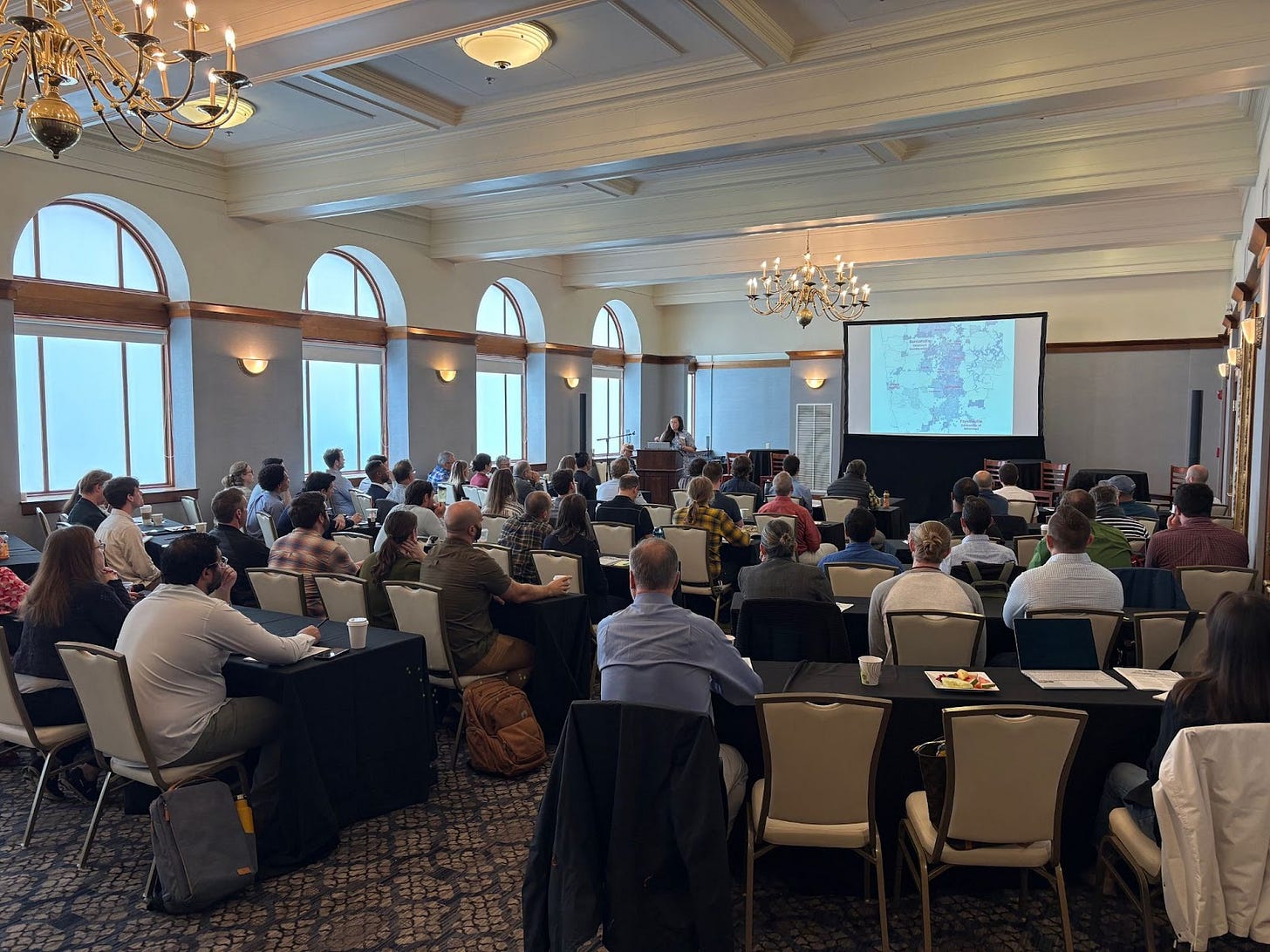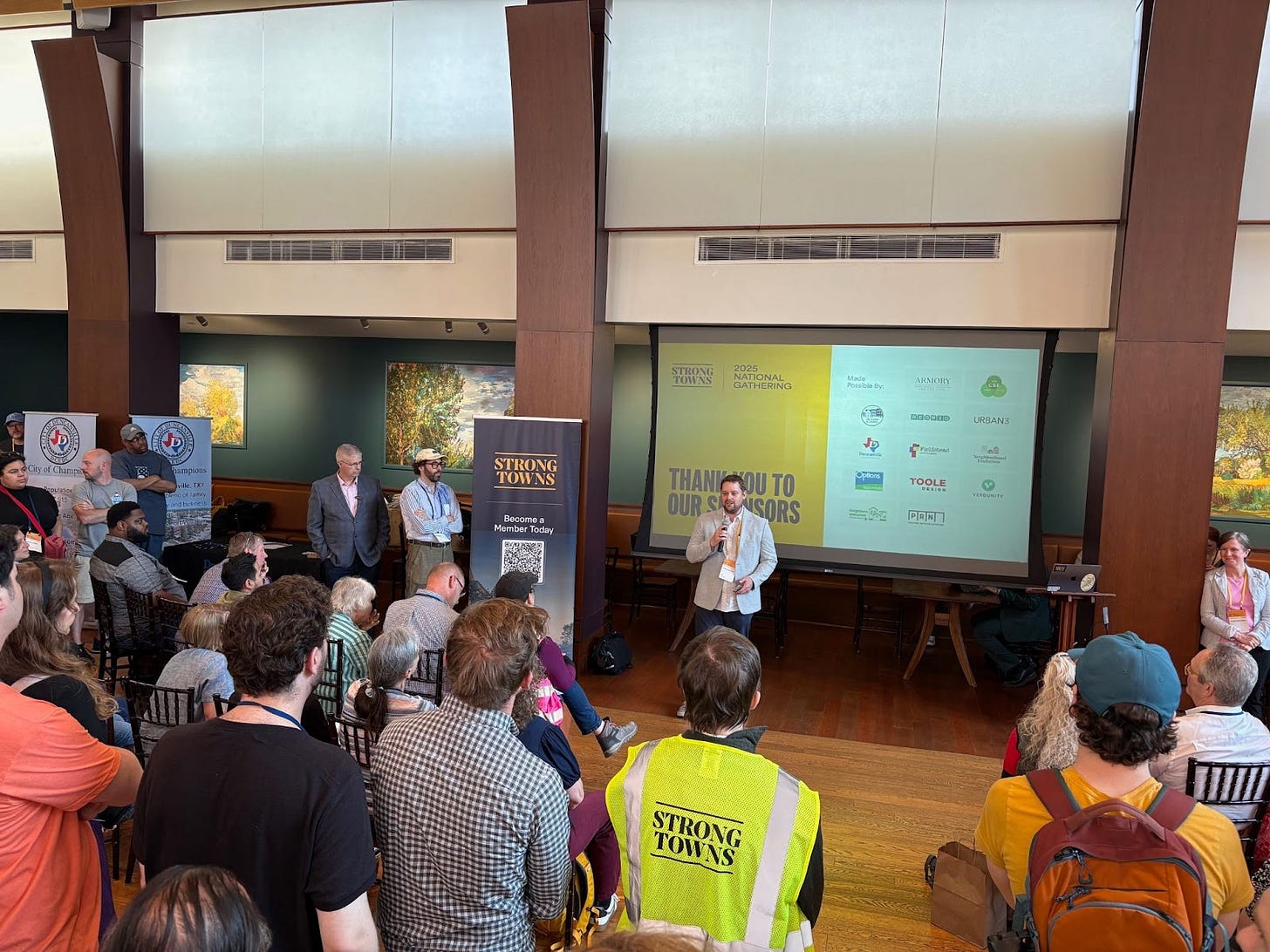I wanted to take a minute to reflect on the experience of hosting the Strong Towns National Gathering in Providence last month and share some musings about the future of the movement.
When Your Favorite Conference Comes to Town

Having a conference come to your hometown is quite a different experience. I loved getting to share my city with the attendees. It’s a nice confidence boost because we’re often focused on all the problems in our place, while your visitors will compliment you on all the great stuff you take for granted. But it was kind of a foot in both worlds and never quite achieving the full conference immersion—school drop off in the morning, conference by day, vomit duty by night! I’m looking forward to next year in NorthWest Arkansas!
As a “founding member,” I’ve been part of the Strong Towns conversation for a long time. I felt like Strong Towns really hit its stride this year, with an expanded and well-curated 2-day program. It felt like seeing a beloved niece or nephew all grown up.
I was particularly glad that Strong Towns had decanted the gathering from a stuffy conference venue. We met in multiple venues across Providence’s historic downtown–Grace Episcopal Church, the Public Library, the Hotel Providence, and the Omni Hotel–which led to a gathering that felt grounded, fresh, and open. Generous 30 minute passing periods provided adequate time for transiting between venues, as well as for the inevitable sessions going over time (don’t look at me!), and for Q/A to continue in the hallway.
As a local, I had helped behind the scenes, identifying venues, planning walking tours, and suggesting speakers. (The Strong Towns staff are my heroes - they made the logistics a breeze. I loved getting to meet all the amazing people behind the scenes.)
I got to lead a group on a walking tour of our company’s neighborhood commercial adaptive reuse, getting into the nitty gritty of how we’ve repurposed mid century light industrial buildings to create offices, gyms, restaurants, breweries, and retail through creative subdivision. Chuck gave a rousing welcome keynote that ended by calling us to the virtues of “stewardship, empathy, and humility” to guide our work. And later I gave a session together with Jesse Kanson-Benanov from Abundant Housing MA and Peter Harrison from Desegregate CT on making abundant housing a reality, which had more attendees than chairs, really bringing the musical chairs metaphor to life.

Where Does Strong Towns Go From Here?
Overall, I saw a movement that is in the process of metamorphosis. From its start as a kinda-cranky1 blog sharing on-the-ground observations and unorthodox ideas, Strong Towns has built a movement of everyday citizens trying to make their communities stronger through ground-up incremental improvement. As the movement has gained steam (7,500+ members, 20+ staff, hundreds of Local Conversations) it is increasing in reach, recognition, and power. Now they can produce a professionally produced conference with 500+ attendees. They have podcasts, books, video and social media content streams. “Stroad” has become a widely used term among professionals and amateurs a-like.
It seems to me that the task of the coming years is to both continue this growth, but also to make some hard choices about what Strong Towns will become—what is on the other side of this metamorphosis. I don’t have a clear vision or prescription here. I don’t even know that we could set a clear (top down!) vision now for 10-years ahead, let alone that it would be desirable. We’ll doubtless be feeling our way forward through iterative trial and error. But, I do foresee at least a couple areas of tension and opportunity.
The first of these is how the Strong Towns movement intersects with other movements and ideological frameworks. At the highest level, we have tried to chart a path not between but outside the ideological camps of the left-progressives and the right-MAGA’s. This isn’t easy, as there are always people who would like to tie us to one or the other movements. I think we sort of have the DNA to follow this middle way. But the terrain will continue to shift and navigating the shifting currents will not be trivial. More difficult, I think, will be charting Strong Towns’ relationship with other more closely allied movements that share a broadly optimistic and pro-change orientation, particularly the YIMBY’s and at a larger scale the nascent “Abundance” movement.
I’ve previously written about some of the reasons Strong Towns and YIMBY’s don’t always seem eye to eye, and I’d like to write more about the interfaces between “Abundance” and Strong Towns in the future. But suffice it to say, in my ecumenical way, we all have things to learn from each other. In particular, I think Strong Towns carries very valuable lessons about the dangers of top-down technocratic planning and the benefits of messy, bottom-up action that (I think) will be very relevant to achieving an optimistic, pro-change future. And if we want to influence would-be technocratic elites to instead practice the Strong Towns virtues of stewardship, empathy, and humility, we’ll have to find a way to address them in ways they will be open to. I think in this same spirit, we need to be humble about the limits of our wisdom and knowledge. For example, I have written in the past about how the idealized “next increment” of development does’t math. There is a lot that we still need to figure out to make bottom-up and messy actually work.
This leads me to the second of these opportunities, the tension between the need for a disciplined, welcoming, coalitional organization to grow and persuade on the one hand. And on the other hand, the need for a curious, rigorous, contentious think-tank to try to answer questions we don’t fully understand.2 These two approaches are in such direct tension that I wonder if the best way to resolve it might not be to create two affiliate organizations, a Strong Towns Movement, and a Strong Towns Institute, or something like that.
What other spheres of action will Strong Towns need to grapple with over the next ten or twenty years if the movement is to continue to grow and achieve the transformation of our relationship with our cities and towns that we aspire to? Let me know what you think in the comments.
No disrespect—I think Chuck would agree!
For what it’s worth, right now I’m more interested in the second—because there’s a lot I don’t understand!







Providence was a great venue and we’re really grateful for all your efforts that made it possible!
Your thoughts all resonate, and I also like the idea of an “institute” for us to drive investigation and testing of ideas ourselves more than we have in the past. It’s exciting to think we could actually do that — even five years ago that would have seemed so ambitious.
Thanks Seth!
An outsider thought: you all may well not know this (why would you?) but there used to be two national planning organizations with distinctly different vibes. I won’t bore us all with the details. The point is that they merged (I voted no on that, but the nays lost decisively). The point is that without the internal dynamic, planning evolved into the relatively bland profession of which you all are pretty critical. The merger was not the only factor, but I think the YIMBY and Strong Towns folks ought to regard their differences as an asset.